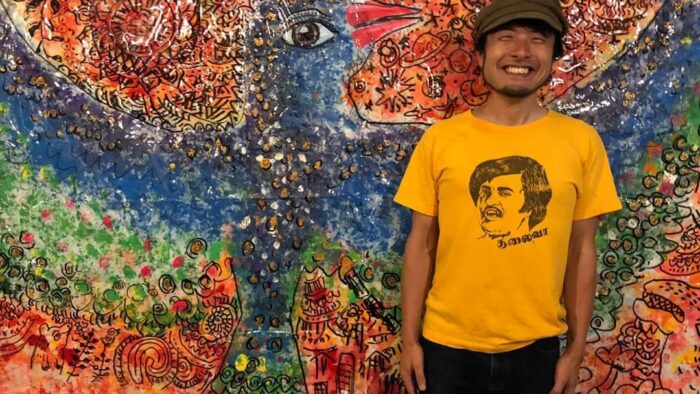Hiroyoshi Takeda is a Japanese national working in Tokyo as an artist. He drives around Tokyo in an auto, with pictures of Subramanya (https://youtu.be/AQABlZaHga4). He says that when he was a child, he had a book on Anthropology at home. “The book was about different countries around the world with beautiful pictures. Among all of them, I was very attracted to India. I was very interested in the magnificent temple sculptures and the different cultures that exist in India. After that, I always wanted to visit this land. “

When he was in high school, he decided to go to art school to become an artist. He did have some doubts though, wondering if it was normal for artists to go to art school to study art. Could people who do ordinary things, become artists. While reading a school catalogue, he found a vocational school which taught Hindi, and since his favourite art was in India, he decided to enroll in that school instead.
After studying Hindi at the Asian and African Language Institute, he visited South India. He says that one of the books that inspired him to visit India had a picture of the Madurai Meenakshi Temple “I like kolams on the front door, the great Carnatic music, folk performing arts, movies, festivals and much more. I like Indian culture and cooking very much. The endless variations inspire endless inquisitiveness. Tamil culture is strangely common to Japanese culture. At first glance, Japanese and Indian cultures look completely different, but there are a number of similarities” he says. In Chennai, not knowing the language, he felt isolated, but engaged himself painting huge walls, in street performances and avant-garde art from the 1960s and 1970s.
Takeda says he likes Indian folk paintings very much and when he first visited India, he visited the village of Warli. He says he also likes Madhubani paintings and Gond paintings.
He had a deep connection with India and formed the Indian unit Masala Wahler with his performing friends. In order to deepen his understanding, he began to learn Tamil. He has danced in various stages as a member of the Indian movie dance team "Sandoshan".

Since 2011, the main axis of his art has changed from primary color paintings with acrylic paints to fine pen drawings with ballpoint pens. “The reason is that you can draw wherever you are with the materials you can get at any time,” he says. The influence from India was reflected in the works, and the themes of ‘repetition’, ‘yin and yang’, ‘spiral’, Buddhism and Hinduism came to be expressed more. In 2014, he started woodblock woodblock prints, and in 2015 he began copperplate prints. From the end of 2017, he began using round pens and school pens instead of ballpoint pens, and again expressed them with a brush. His solo exhibitions are held once or twice a year. He also participates in various special exhibitions.
Takeda says that he has had no specialized education in Japanese art or Indian art. “Both are so diverse that they cannot be expressed in one word. However, I feel that Japanese art has a great influence from India. Japan and India have an old connection through Buddhism. In Buddhism, Hindu gods are also introduced to Japan. In religious paintings, it seems that Indian motifs are drawn using Chinese brush technique.” The portrayal of nature, relationships with animals, myths, diversity, philosophy are common to both Indian and Japanese art, says Takeda.

Takeda always adds a short poem to his art work and he says people like these poems. In his solo exhibitions, he also makes clay works and people look forward to this. He loves painting elephants as he feels they are a symbol of nature. “Elephants are very intelligent, kind, sometimes dangerous and powerful. Drawing an elephant is a lot of fun. I also love drawing cows. Since animals do not have human facial expressions, they can be expressed without being limited to one. It's like the god's eyes on religious paintings.





